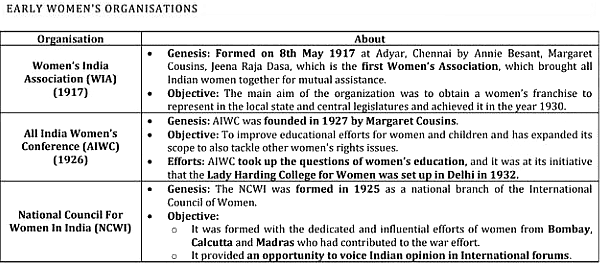Historical Perspective | Indian Society for UPSC CSE PDF Download
Role of Women- Historical Perspective
The history of women in India is the story of progressive decline. Mother nature made women an equal half of human society, but unfortunately, the patriarch society made them subordinate in many ways.
Under the influence of modern education, a set of social reformers campaigned for legislation which would uplift the status of women in society. However, in spite of some efforts, a lot of problems are being faced by women
Indus Valley Civilization
- Worship of the mother goddess highlights the respect to women as mothers.
- Given equal honor along with men in society.
- Women enjoyed full freedom and were treated on par with men
RIG VEDIC (1500 BC – 1000 BC)
- Status: Women were dignified with a respectable status, and enjoyed complete freedom in every sphere.
- Example: There were women poets like Apala, Viswavara, Ghosa, and Lopamudra during this era which is also called the Rig Vedic period.
THE LATER VEDIC PERIOD (1000 BC–600 BC)
- Status: The women were reduced to "Shudras" in the early legal texts. They were not entitled to any property, with the exception of some personal property ('stridhana').
- Women lost their political rights to participate in elections and the ability to read Vedic scriptures.
- Exceptions: However, the women in the royal and rich households enjoyed certain privileges and reached the pinnacle of fame e.g., Gargi and Maitreyi.
THE JAINISM AND BUDDHISM PERIOD (600 BC–200 BC)
- Status: Buddhist philosophy encouraged women to lead a liberal and honourable life. Many women took a leading role in Buddhist monastic life, women had their sangha called the Bhikshuni Sangha
- Example:
- Due to the generally tolerant Buddhist worldview, women were able to restore some of their lost independence and prestige under the compassionate rule of the legendary Buddhist emperors Chandragupta Maurya, Ashoka, Sri Harsha, and others.
- In Buddhist monastic life, many women assumed leadership positions; they even had their own sangha, known as the Bhikshuni Sangha.
MEDIEVAL PERIOD (6TH – 13TH CENTURY AD)
- Status: During the era of Muslim kings, the existing social evils became more prominent like female infanticide, no education for girls, child marriage, Jauhar. Etc.
- Efforts:
- However, the position of women in India considerably improved with the rise of the bhakti movement and Sufism.
- Regardless of caste or religion, prominent individuals like Shankaracharya, Ramanuja, and Guru Nanak vehemently opposed mistreating and suppressing women.
Women in Bhakti Movement
The liberal current, which to some extent widened the horizon of women, was the Bhakti movements, the medieval saints’ movements. Female poet saints also played a significant role in the bhakti movement at large. Bhakti movements which flourished during the medieval age gave rise to a new class of men and women who cared little for gender bias.
In many cases, they rejected traditional women’s roles and societal norms by leaving families and homes altogether, choosing to become wandering bhaktas. In some instances they formed communities with other poet saints.
Famous Women during this Period
- Janabai: Janabai was born around the 13th century in Maharashtra in a low caste sudra family. She was sent to work in the upper caste family of Namdev, one of the most revered of the bhakti poet saints
- Akkamahadevi: Akkamahadevi, also known as Akka or Mahadevi was a bhakta from the southern region of Karnataka and a devotee of Shiva in the 12th century CE
- Mirabai: Mirabai, or Mira is said to have been born into a ruling Rajput Mirabai’s poetry tells about her vision of Lord Krishna when she was a child; from that point on Mira vowed that she would forever be his bride.
- Bahinabhai: Bahinabai was a poet saint from 17th century Maharashtra. written in the form of abangas, women’s songs that accompanied their labors, especially in the fields. Her writings are particularly autobiographical, recounting her childhood, puberty and married life.
DURING THE COLONIAL PERIOD
At the end of the Nineteenth Century women in India suffered from disabilities like:- Child marriage,
- Practice of polygamy,
- Sale of girls for marriage purposes,
- Severe restrictions on widows,
- Non access to education
- Restricting oneself to domestic
- Childbearing functions.
Influence of modern ideas and the efforts of Ram Mohan Roy, Radhakanta Deb, and Ishwar Chandra Vidyasagar, the practice of ‘sati’ was banned in 1829.
The Bengal Sati Regulation of 1829, the Hindu Widows' Remarriage Act of 1856, the Female Infanticide Prevention Act of 1870, and the Age of Consent Act of 1891 are just a few of the ameliorative laws that were passed.
|
21 videos|124 docs
|
FAQs on Historical Perspective - Indian Society for UPSC CSE
| 1. Who were some prominent women figures in the Bhakti Movement? |  |
| 2. How did women contribute to the Bhakti Movement? |  |
| 3. What were some common themes in the poetry of women in the Bhakti Movement? |  |
| 4. How did the Bhakti Movement impact the status of women in society? |  |
| 5. How is the legacy of women in the Bhakti Movement remembered today? |  |

















